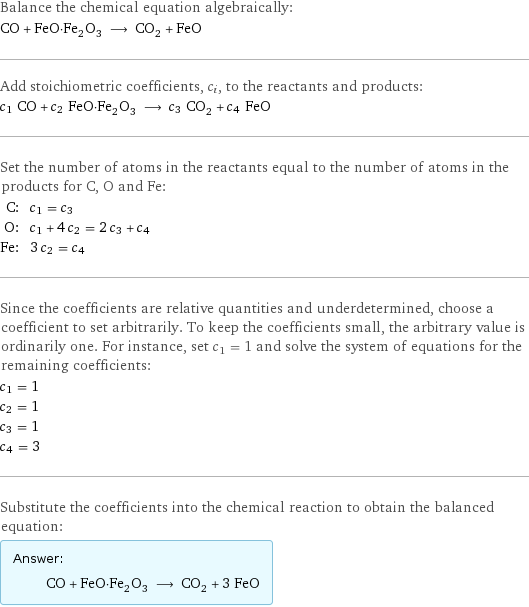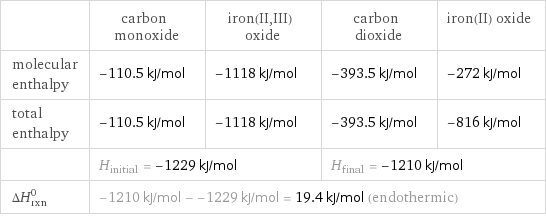Input interpretation

CO (carbon monoxide) + FeO·Fe_2O_3 (iron(II, III) oxide) ⟶ CO_2 (carbon dioxide) + FeO (iron(II) oxide)
Balanced equation

Balance the chemical equation algebraically: CO + FeO·Fe_2O_3 ⟶ CO_2 + FeO Add stoichiometric coefficients, c_i, to the reactants and products: c_1 CO + c_2 FeO·Fe_2O_3 ⟶ c_3 CO_2 + c_4 FeO Set the number of atoms in the reactants equal to the number of atoms in the products for C, O and Fe: C: | c_1 = c_3 O: | c_1 + 4 c_2 = 2 c_3 + c_4 Fe: | 3 c_2 = c_4 Since the coefficients are relative quantities and underdetermined, choose a coefficient to set arbitrarily. To keep the coefficients small, the arbitrary value is ordinarily one. For instance, set c_1 = 1 and solve the system of equations for the remaining coefficients: c_1 = 1 c_2 = 1 c_3 = 1 c_4 = 3 Substitute the coefficients into the chemical reaction to obtain the balanced equation: Answer: | | CO + FeO·Fe_2O_3 ⟶ CO_2 + 3 FeO
Structures

+ ⟶ +
Names

carbon monoxide + iron(II, III) oxide ⟶ carbon dioxide + iron(II) oxide
Reaction thermodynamics
Enthalpy

| carbon monoxide | iron(II, III) oxide | carbon dioxide | iron(II) oxide molecular enthalpy | -110.5 kJ/mol | -1118 kJ/mol | -393.5 kJ/mol | -272 kJ/mol total enthalpy | -110.5 kJ/mol | -1118 kJ/mol | -393.5 kJ/mol | -816 kJ/mol | H_initial = -1229 kJ/mol | | H_final = -1210 kJ/mol | ΔH_rxn^0 | -1210 kJ/mol - -1229 kJ/mol = 19.4 kJ/mol (endothermic) | | |
Gibbs free energy

| carbon monoxide | iron(II, III) oxide | carbon dioxide | iron(II) oxide molecular free energy | -137 kJ/mol | -1015 kJ/mol | -394.4 kJ/mol | -255 kJ/mol total free energy | -137 kJ/mol | -1015 kJ/mol | -394.4 kJ/mol | -765 kJ/mol | G_initial = -1152 kJ/mol | | G_final = -1159 kJ/mol | ΔG_rxn^0 | -1159 kJ/mol - -1152 kJ/mol = -7 kJ/mol (exergonic) | | |
Equilibrium constant
![Construct the equilibrium constant, K, expression for: CO + FeO·Fe_2O_3 ⟶ CO_2 + FeO Plan: • Balance the chemical equation. • Determine the stoichiometric numbers. • Assemble the activity expression for each chemical species. • Use the activity expressions to build the equilibrium constant expression. Write the balanced chemical equation: CO + FeO·Fe_2O_3 ⟶ CO_2 + 3 FeO Assign stoichiometric numbers, ν_i, using the stoichiometric coefficients, c_i, from the balanced chemical equation in the following manner: ν_i = -c_i for reactants and ν_i = c_i for products: chemical species | c_i | ν_i CO | 1 | -1 FeO·Fe_2O_3 | 1 | -1 CO_2 | 1 | 1 FeO | 3 | 3 Assemble the activity expressions accounting for the state of matter and ν_i: chemical species | c_i | ν_i | activity expression CO | 1 | -1 | ([CO])^(-1) FeO·Fe_2O_3 | 1 | -1 | ([FeO·Fe2O3])^(-1) CO_2 | 1 | 1 | [CO2] FeO | 3 | 3 | ([FeO])^3 The equilibrium constant symbol in the concentration basis is: K_c Mulitply the activity expressions to arrive at the K_c expression: Answer: | | K_c = ([CO])^(-1) ([FeO·Fe2O3])^(-1) [CO2] ([FeO])^3 = ([CO2] ([FeO])^3)/([CO] [FeO·Fe2O3])](../image_source/03a45ae3fb2620432f3af64cc446db98.png)
Construct the equilibrium constant, K, expression for: CO + FeO·Fe_2O_3 ⟶ CO_2 + FeO Plan: • Balance the chemical equation. • Determine the stoichiometric numbers. • Assemble the activity expression for each chemical species. • Use the activity expressions to build the equilibrium constant expression. Write the balanced chemical equation: CO + FeO·Fe_2O_3 ⟶ CO_2 + 3 FeO Assign stoichiometric numbers, ν_i, using the stoichiometric coefficients, c_i, from the balanced chemical equation in the following manner: ν_i = -c_i for reactants and ν_i = c_i for products: chemical species | c_i | ν_i CO | 1 | -1 FeO·Fe_2O_3 | 1 | -1 CO_2 | 1 | 1 FeO | 3 | 3 Assemble the activity expressions accounting for the state of matter and ν_i: chemical species | c_i | ν_i | activity expression CO | 1 | -1 | ([CO])^(-1) FeO·Fe_2O_3 | 1 | -1 | ([FeO·Fe2O3])^(-1) CO_2 | 1 | 1 | [CO2] FeO | 3 | 3 | ([FeO])^3 The equilibrium constant symbol in the concentration basis is: K_c Mulitply the activity expressions to arrive at the K_c expression: Answer: | | K_c = ([CO])^(-1) ([FeO·Fe2O3])^(-1) [CO2] ([FeO])^3 = ([CO2] ([FeO])^3)/([CO] [FeO·Fe2O3])
Rate of reaction
![Construct the rate of reaction expression for: CO + FeO·Fe_2O_3 ⟶ CO_2 + FeO Plan: • Balance the chemical equation. • Determine the stoichiometric numbers. • Assemble the rate term for each chemical species. • Write the rate of reaction expression. Write the balanced chemical equation: CO + FeO·Fe_2O_3 ⟶ CO_2 + 3 FeO Assign stoichiometric numbers, ν_i, using the stoichiometric coefficients, c_i, from the balanced chemical equation in the following manner: ν_i = -c_i for reactants and ν_i = c_i for products: chemical species | c_i | ν_i CO | 1 | -1 FeO·Fe_2O_3 | 1 | -1 CO_2 | 1 | 1 FeO | 3 | 3 The rate term for each chemical species, B_i, is 1/ν_i(Δ[B_i])/(Δt) where [B_i] is the amount concentration and t is time: chemical species | c_i | ν_i | rate term CO | 1 | -1 | -(Δ[CO])/(Δt) FeO·Fe_2O_3 | 1 | -1 | -(Δ[FeO·Fe2O3])/(Δt) CO_2 | 1 | 1 | (Δ[CO2])/(Δt) FeO | 3 | 3 | 1/3 (Δ[FeO])/(Δt) (for infinitesimal rate of change, replace Δ with d) Set the rate terms equal to each other to arrive at the rate expression: Answer: | | rate = -(Δ[CO])/(Δt) = -(Δ[FeO·Fe2O3])/(Δt) = (Δ[CO2])/(Δt) = 1/3 (Δ[FeO])/(Δt) (assuming constant volume and no accumulation of intermediates or side products)](../image_source/269ceeabc37beb49135e3c128f32148a.png)
Construct the rate of reaction expression for: CO + FeO·Fe_2O_3 ⟶ CO_2 + FeO Plan: • Balance the chemical equation. • Determine the stoichiometric numbers. • Assemble the rate term for each chemical species. • Write the rate of reaction expression. Write the balanced chemical equation: CO + FeO·Fe_2O_3 ⟶ CO_2 + 3 FeO Assign stoichiometric numbers, ν_i, using the stoichiometric coefficients, c_i, from the balanced chemical equation in the following manner: ν_i = -c_i for reactants and ν_i = c_i for products: chemical species | c_i | ν_i CO | 1 | -1 FeO·Fe_2O_3 | 1 | -1 CO_2 | 1 | 1 FeO | 3 | 3 The rate term for each chemical species, B_i, is 1/ν_i(Δ[B_i])/(Δt) where [B_i] is the amount concentration and t is time: chemical species | c_i | ν_i | rate term CO | 1 | -1 | -(Δ[CO])/(Δt) FeO·Fe_2O_3 | 1 | -1 | -(Δ[FeO·Fe2O3])/(Δt) CO_2 | 1 | 1 | (Δ[CO2])/(Δt) FeO | 3 | 3 | 1/3 (Δ[FeO])/(Δt) (for infinitesimal rate of change, replace Δ with d) Set the rate terms equal to each other to arrive at the rate expression: Answer: | | rate = -(Δ[CO])/(Δt) = -(Δ[FeO·Fe2O3])/(Δt) = (Δ[CO2])/(Δt) = 1/3 (Δ[FeO])/(Δt) (assuming constant volume and no accumulation of intermediates or side products)
Chemical names and formulas

| carbon monoxide | iron(II, III) oxide | carbon dioxide | iron(II) oxide formula | CO | FeO·Fe_2O_3 | CO_2 | FeO Hill formula | CO | Fe_3O_4 | CO_2 | FeO name | carbon monoxide | iron(II, III) oxide | carbon dioxide | iron(II) oxide IUPAC name | carbon monoxide | | carbon dioxide | oxoiron